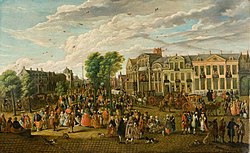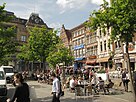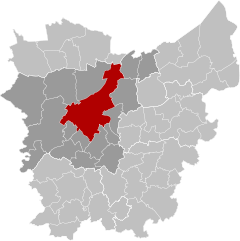
A | B | C | D | E | F | G | H | CH | I | J | K | L | M | N | O | P | Q | R | S | T | U | V | W | X | Y | Z | 0 | 1 | 2 | 3 | 4 | 5 | 6 | 7 | 8 | 9
Ghent
Gent (Dutch) Gand (French) | |
|---|---|
City and municipality | |
Clockwise from top: the Graslei, the Gravensteen, Ghent Tower Row (St. Nicholas' Church, Belfry, St. Bavo's Cathedral), and the Vrijdagmarkt | |
| Coordinates: 51°03′13″N 03°43′31″E / 51.05361°N 3.72528°E | |
| Country | |
| Community | Flemish Community |
| Region | Flemish Region |
| Province | East Flanders |
| Arrondissement | Ghent |
| Government | |
| • Mayor (list) | Mathias De Clercq (Open VLD) |
| • Governing party/ies | Vooruit-Groen, Open VLD, CD&V |
| Area | |
| • Total | 157.77 km2 (60.92 sq mi) |
| Population (2022-01-01)[1] | |
| • Total | 265,086 |
| • Density | 1,700/km2 (4,400/sq mi) |
| Postal codes | 9000–9052 |
| NIS code | 44021 |
| Area codes | 09 |
| Website | www.gent.be |
 Logo of Ghent | |
Ghent (Dutch: Gent [ɣɛnt] ; French: Gand [ɡɑ̃] ; historically known as Gaunt in English) is a city and a municipality in the Flemish Region of Belgium. It is the capital and largest city of the East Flanders province, and the third largest in the country, after Brussels and Antwerp.[2] It is a port and university city.
The city originally started as a settlement at the confluence of the Rivers Scheldt and Leie and in the Late Middle Ages became one of the largest and richest cities of northern Europe, with some 50,000 people in 1300. After the late 16th century Ghent became a less important city, resulting in an extremely well-preserved historic centre, that now makes Ghent an important destination of tourism.
The municipality comprises the city of Ghent proper and the surrounding suburbs of Afsnee, Desteldonk, Drongen, Gentbrugge, Ledeberg, Mariakerke, Mendonk, Oostakker, Sint-Amandsberg, Sint-Denijs-Westrem, Sint-Kruis-Winkel, Wondelgem and Zwijnaarde. With 262,219 inhabitants at the beginning of 2019, Ghent is Belgium's second largest municipality by number of inhabitants. The metropolitan area, including the outer commuter zone, covers an area of 1,205 km2 (465 sq mi) and had a total population of 560,522 as of 1 January 2018, which ranks it as the fourth most populous in Belgium.[3][4] The current mayor of Ghent is Mathias De Clercq (Open Vld).
The ten-day-long Ghent Festival (Gentse Feesten) is held every year and attended by about 1–1.5 million visitors.
History
This section needs additional citations for verification. (May 2013) |
Archaeological evidence shows human presence around the confluence of the Scheldt and the Leie going back as far as the Stone Age and the Iron Age.[5]
Most historians believe that the older name for Ghent, 'Ganda', is derived from the Celtic word ganda, which means ‘confluence’,[5] or ‘river mouth’, referring to the Leie river debouching into the Scheldt. Other sources connect its name with an obscure deity named Gontia.[6]
There are no written records of the Roman period, but archaeological research confirms that the Gent area continued to be inhabited.
When the Franks invaded the Roman territories from the end of the 4th century and well into the 5th century, they brought their language with them, and Celtic and Latin were replaced by Old Dutch.
Middle Ages

Around 650, Saint Amand founded two abbeys in Ghent: St. Peter's (Blandinium) and St. Bavo's Abbey. Around 800, Louis the Pious, son of Charlemagne, appointed Einhard, the biographer of Charlemagne, abbot of both abbeys. The city grew from several nuclei, the abbeys, and a commercial centre. However, in 851 and 879 the city was plundered by Vikings.
Under the protection of the County of Flanders the city recovered and flourished from the 11th century, growing to become a small city-state. By the 13th century, Ghent was the biggest city in Europe north of the Alps after Paris; it was bigger than Cologne or Moscow.[7] Up to 65,000 people lived within the city walls. The belfry and the towers of the St. Bavo's Cathedral and St. Nicholas' Church are just a few examples of the skyline of the period.
The rivers flowed in an area where much land was periodically flooded. These rich grass 'meersen' ("water-meadows": a word related to the English 'marsh') were ideally suited for herding sheep, the wool of which was used to make cloth. Ghent was the leading city for cloth during the Middle Ages.
The wool industry, originally established at Bruges, created the first European industrialized zone in Ghent in the High Middle Ages. The mercantile zone was so highly developed that wool had to be imported from Scotland and England, which led to Flanders' good relationship with them. However, during the Hundred Years' War, trade with England suffered significantly. Ghent was the birthplace of John of Gaunt, Duke of Lancaster.
Early modern period
The city recovered in the 15th century when Flanders was united with neighbouring provinces under the Dukes of Burgundy. High taxes led to a rebellion and eventually to the Battle of Gavere in 1453, in which Ghent suffered a terrible defeat at the hands of Philip the Good. Around this time the centre of political and social importance in the Low Countries started to shift from Flanders (Bruges–Ghent) to Brabant (Antwerp–Brussels), although Ghent continued to play an important role. With Bruges, the city led two revolts against Maximilian of Austria, the first monarch of the House of Habsburg to rule Flanders.


In 1500, Juana of Castile gave birth to Charles V, who became Holy Roman Emperor and King of Spain. Although native to Ghent, he punished the city after the 1539 Revolt of Ghent and obliged the city's nobles to walk in front of the Emperor barefoot with a noose (Dutch: "strop") around the neck; since this incident, the people of Ghent have been called "Stroppendragers" (noose bearers). St. Bavo's Abbey (not to be confused with the nearby St. Bavo's Cathedral) was abolished, torn down, and replaced with a fortress for Royal Spanish troops. Only a small portion of the abbey was spared demolition.


The late 16th and 17th centuries brought devastation because of the Eighty Years' War. The war ended the role of Ghent as a centre of international importance. In 1745, the city was captured by French forces during the War of the Austrian Succession before being returned to the Empire of Austria under the House of Habsburg following the Treaty of Aix-la-Chapelle in 1748. This part of Flanders became known as the Austrian Netherlands until the exile of the French Emperor Napoleon I, the end of the French Revolutionary and later Napoleonic Wars, and the peace treaties arrived at by the Congress of Vienna in 1815.
19th century

In the 18th and 19th centuries, Ghent's textile industry flourished again. Lieven Bauwens, having smuggled the industrial and factory machine plans out of England, introduced the first mechanical weaving machine on the European continent in 1800.
The Treaty of Ghent, negotiated here and adopted on Christmas Eve 1814, formally ended the War of 1812 between Great Britain and the United States (the North American phase of the Napoleonic Wars). After the Battle of Waterloo, Ghent and Flanders, previously ruled from the House of Habsburg in Vienna as the Austrian Netherlands, became a part of the United Kingdom of the Netherlands with the northern Dutch for 15 years. In this period, Ghent established its own university (1816)[8] and a new connection to the sea (1824–27).
After the Belgian Revolution, with the loss of port access to the sea for more than a decade, the local economy collapsed, and the first Belgian trade union originated in Ghent. In 1913 there was a world exhibition in Ghent.[8] As a preparation for these festivities, the Sint-Pieters railway station was completed in 1912.
20th century
Ghent was occupied by the Germans in both World Wars but escaped severe destruction. The life of the people and the German invaders in Ghent during World War I is described by H. Wandt in "etappenleven te Gent".[9] In World War II the city was liberated by the British 7th "Desert Rats" Armoured Division and local Belgian fighters on 6 September 1944, with the northern suburbs and the industrial area cleared over the following days by the 15th (Scottish) Infantry Division.
Geography

After the fusions of municipalities in 1965 and 1977, the city is made up of following sub-municipalities:
- I Ghent
- II Mariakerke
- III Drongen
- IV Wondelgem
- V Sint-Amandsberg
- VI Oostakker
- VII Desteldonk
- VIII Mendonk
- IX Sint-Kruis-Winkel
- X Ledeberg
- XI Gentbrugge
- XII Afsnee
- XIII Sint-Denijs-Westrem
- XIV Zwijnaarde
Neighbouring municipalities
Climate
The climate in this area has mild differences between highs and lows, and there is adequate rainfall year-round. According to the Köppen climate classification system, Ghent has a marine west coast climate, abbreviated "Cfb" on climate maps.[10]
| Climate data for Ghent (1981–2010 normals, sunshine 1984–2013) | |||||||||||||
|---|---|---|---|---|---|---|---|---|---|---|---|---|---|
| Month | Jan | Feb | Mar | Apr | May | Jun | Jul | Aug | Sep | Oct | Nov | Dec | Year |
| Mean daily maximum °C (°F) | 6.2 (43.2) |
7.0 (44.6) |
10.8 (51.4) |
14.5 (58.1) |
18.1 (64.6) |
20.6 (69.1) |
23.0 (73.4) |
22.9 (73.2) |
19.7 (67.5) |
15.3 (59.5) |
10.1 (50.2) |
6.5 (43.7) |
14.7 (58.5) |
| Daily mean °C (°F) | 3.4 (38.1) |
3.8 (38.8) |
6.8 (44.2) |
9.4 (48.9) |
13.2 (55.8) |
15.9 (60.6) |
18.1 (64.6) |
17.9 (64.2) |
14.9 (58.8) |
11.2 (52.2) |
7.0 (44.6) |
4.0 (39.2) |
10.6 (51.1) |
| Mean daily minimum °C (°F) | 0.7 (33.3) |
0.4 (32.7) |
2.7 (36.9) |
4.5 (40.1) |
8.3 (46.9) |
11.1 (52.0) |
13.2 (55.8) |
12.8 (55.0) |
10.2 (50.4) |
7.2 (45.0) |
3.9 (39.0) |
1.5 (34.7) |
6.4 (43.5) |
| Average precipitation mm (inches) | 70.7 (2.78) |
56.2 (2.21) |
61.5 (2.42) |
50.6 (1.99) |
63.1 (2.48) |
74.3 (2.93) |
77.4 (3.05) |
84.2 (3.31) |
74.2 (2.92) |
81.7 (3.22) |
82.7 (3.26) |
82.2 (3.24) |
858.8 (33.81) |
| Average precipitation days | 12.6 | 10.8 | 12.0 | 10.1 | 11.1 | 10.5 | 10.3 | 10.0 | 10.9 | 12.1 | 13.4 | 13.0 | 136.8 |
| Mean monthly sunshine hours | 61 | 79 | 123 | 172 | 204 | 196 | 209 | 196 | 144 | 118 | 66 | 50 | 1,618 |
| Source: Royal Meteorological Institute[11] | |||||||||||||
Demographics
Nationalities
Ghent is home to many people of foreign origin and immigrants. The 2020 census[12] revealed that 35.5% of the inhabitants had roots outside of Belgium and 15.3% had a non-Belgian nationality. Many neighbourhoods already have a minority-majority population, primarily in the north, east, and west of the city and some pockets in the south. Some examples are Brugse Poort, Dampoort, Rabot, Ledeberg, Nieuw Gent/UZ and the area around Sleepstraat (known for its many Turkish restaurants).
| Group of origin | Year | |
|---|---|---|
| 2023[13] | ||
| Number | % | |
| Belgians with Belgian background | 165,164 | 61.6% |
| Belgians with foreign background | 56,990 | 21.26% |
| Neighboring country | 5,523 | 2.06% |
| EU27 (excluding neighboring country) | 5,354 | 2% |
| Outside EU 27 | 46,113 | 17.2% |
| Non-Belgians | 45,968 | 17.14% |
| Neighboring country | 4,691 | 1.75% |
| EU27 (excluding neighboring country) | 20,355 | 7.59% |
| Outside EU 27 | 20,922 | 7.8% |
| Total | 268,122 | 100% |
Politics
The current compostion of the city council (2018-2025):








